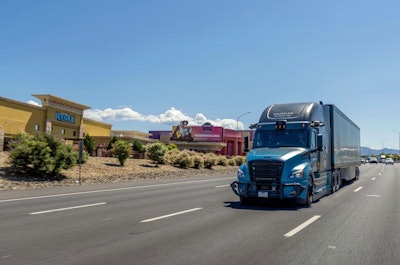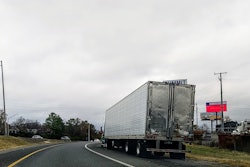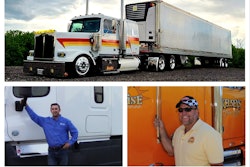
It wasn’t exactly a Dukes of Hazzard moment, but when an autonomous vehicle took off from an officer during a traffic stop in California, it definitely served as a reminder of the challenges that can come up as law enforcement agencies, autonomous tech developers, fleets and trade groups continue to work together to improve interactions between people and computer-controlled vehicles.
Nearly eight months after the incident, it's still unclear why an autonomous GM Cruise car with no driving attendant made the decision to pull away from a San Francisco cop. Video posted by KTVU shows the car stopped along a city street with a police car behind it. Moments later with the blue lights of the officer’s car still flashing, the Chevy Bolt bolts off.
GM Cruise told KTVU that once the autonomous vehicle pulled away from police, they assumed control of the car and stopped it along the side of the street a short distance from where it had been originally pulled over. A police car can be seen pulling up behind it again in the video.
As Commercial Carrier Journal learned recently at an autonomous Freightliner demonstration held by Daimler subsidiary Torc in Albuquerque, New Mexico, autonomous driving systems are equipped with various backups, or redundancies, to enable safer driving conditions, including interactions with law enforcement.

Like Cruise, Torc’s Mission Control keeps a constant eye on its autonomous trucks and can intervene when necessary. “Law enforcement interaction is a part of our roadmap, and we will be working closely with law enforcement and first responders to develop solutions for effective communication,” said Walter Grigg, program manager of product strategy at Torc. “Our Mission Control product will be a key enabler of law enforcement interaction."
[Related: Autonomous Torc truck mostly a boring ride]
Jeff Farrah, executive director of the Autonomous Vehicle Industry Association (AVIA), told CCJ that “autonomous trucks are developed to recognize and respond appropriately to emergency vehicles and law enforcement – whether slowing down/pulling over to allow them to pass, or pulling over when approached by law enforcement. Companies have been working closely with law enforcement and safety officials on procedures for stops.”
Communication policies between AVs and law enforcement are still being developed. One of the first tools officers have is to call the AV company or fleet about the vehicle in question. Obtaining information about the vehicle, such as insurance and registration, can be carried out electronically or through actual papers presented for law enforcement.
“For example, Embark has a communication protocol and standard operating procedure for law enforcement interaction during traffic stops,” Farrah said. “A deputy confirms the truck is safe to approach with an external display on the truck’s side before accessing the truck’s documentation in an external lockbox.”
Working in conjunction with the Texas Department of Public Safety and the Travis County Sheriff’s Office, autonomous trucking technology company Embark Trucks developed the capability for Embark-powered semis to identify and stop for law enforcement vehicles; built communication protocols and standard operating procedures between autonomous trucks and officers; and in August completed the first known public demonstration of an autonomous truck being pulled over by law enforcement and participating in a routine traffic stop on a public highway.
[Related: TuSimple, Navistar end partnership after 2 years]
In addition to pulling over when pursued by law enforcement, TuSimple spokesperson Megan Strader pointed out that autonomous trucks also need to be able to effectively respond to officers for other reasons.
“When we detect a law enforcement vehicle stopped on the side of the road, our autonomous driving system is designed to change lanes to give additional space, and slow down to increase safety,” Strader said. “Additionally, we relay this information to other TuSimple trucks traveling on the same route through live updates of our HD Digital Map, adding another layer of safety.”
While traveling, TuSimple’s technology will also slow the truck down and provide more space between it and an officer ahead. It also has the ability to detect roadblocks.
“Our perception system is also able to identify if a law enforcement vehicle has stopped in the roadway,” Strader said. “For example, if they are creating a roadblock, TuSimple’s trucks will safely come to a stop.”
Obeying physical cues from an officer, such as hand motions for directing traffic, is also in the works, Strader added.
As far as truck inspections are concerned, AV industry players including law enforcement worked alongside the Commercial Vehicle Safety Alliance to develop the Enhanced Commerical Motor Vehicle Inspection Program for autonomous trucks.
Announced in October, the program requires carrier personnel to take on the role of inspectors at the point of departure. Inspectors will undergo a 40-hour CVSA training course and exam for conducting inspections.
“For the new program, rather than the driver conducting a pre-trip inspection (as is currently done), for ADS vehicles, CVSA-trained motor carrier personnel will conduct the Enhanced CMV Inspection Procedure on selected ADS-equipped vehicles from their fleets at the point of origin before dispatch, as well as in-transit inspections at a dictated interval throughout the trip,” CVSA announced.
[Related: FMCSA's electronic-ID questions, Level 8 wireless inspections, autonomous trucks]













